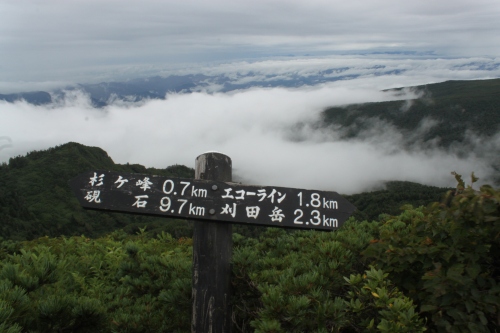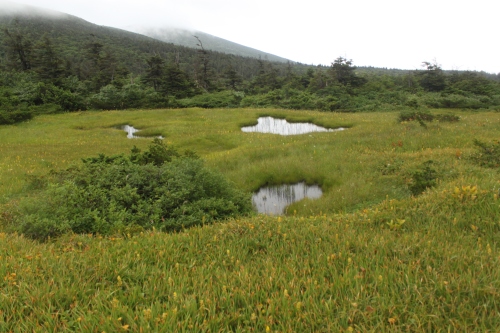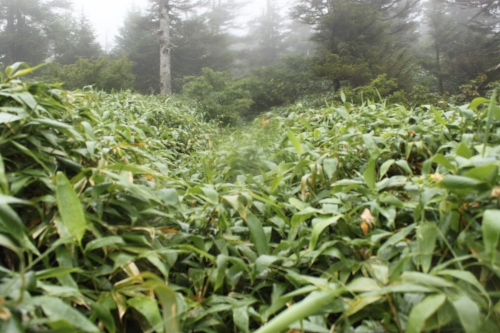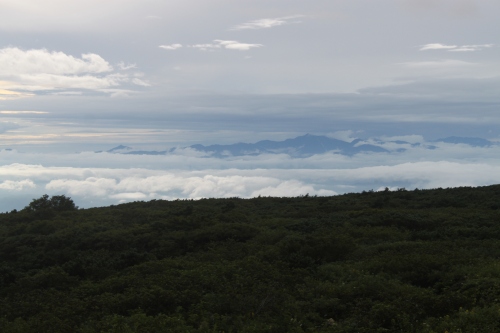The last remaining peak in Kyoto, and northern Kansai for that matter, refused to surrender peacefully. Back in late August, the thunder and torrential rain sent me scrambling for shelter, forfeiting any chance of knocking off the peak. A mid-October stable high pressure system brought a rare opportunity for revenge, so this time my trusty Kyoto confrère William joined me alongside newcomer Ed. William needs no introduction to readers of this blog, but those unfamiliar with the Hyakumeizan stalwart can get some background about the Kid and the Missus here.

The five of us set off from Demachiyanagi station after stocking up on supplies at the celebrated onigiri shop just a short hop from the ticket gates. After a couple of wrong turns through the twisty, narrow backroads of the ancient capital, we finally hit route 162, a byway that weaved along hills bursting with thick rows of Kitayama cedar trees rising abruptly from the narrow valley hugging both sides of a tributary of the Yura river. Further up the river basin the valley widened, passing villages of thatched farmhouses unswayed by the winds of change that have overtaken most of rural Japan. It was here that our journey turned west, skirting past a dammed section of river before curving around the southern flank of Mt. Chōrō in favor of a more leisurely ascent of the northern face. Or so we thought.

We pulled into the trailhead shortly after 11am, following a gravel forest road that hugged a stream glistening with emerald green water. While the walk was quite pleasant, a quick study of the GPS revealed that we were indeed walking up the completely wrong valley, so after retreating back to the car, the mistake was quickly solved by navigating the wheels one forest road to the right. We parked the car near a chain-link gate bolted securely across the paved forest road. You run into these roads all over Japan, whose asphalt is off limits except for those who work for the logging companies or those lucky enough to have access to the keys to the padlocks that are always tightly fastened to the gates like locked fortresses. We hit the road with our legs, with Ed and I pushing ahead while William and company took a more leisurely approach. Our haste was not without flaw, however, as we missed out on seeing a poisonous snake slithering along a ditch used for channeling rainwater down the slopes.

My map told me that we would have to follow this forest road all the way to the summit, but the charts also hinted at an old dotted route that cut through the paved switchbacks in a more direct approach to the top. Though the dotted trail did not register on the GPS, the five of us abandoned the road for a more scenic route. The trail immediately dissipated into a narrow creek framed on all sides by steep slopes. We headed right, skirting past an impossibly large beech tree balanced precariously on the 50-degree angle of the mountainside. The adults had no trouble with the inclinations, but for the Kid it was a monstrous effort. At one point the angle became too great, so we headed back towards the creek bed in search of a better route. If we had stuck with the road we would surely be on the summit by now, but Chōrō wasn’t about to give in so easily it seemed. Once we reached the safe havens of the waters, a choice was made to climb a spine on the opposite bank of the stream, as the angle was much more manageable. I once again took the helm of leader, punching through shrubs of rhododendron and towers of red pine in route to the mountain ridge.
Trees made for trusty handholds while the tree roots eased the burden on the foot work. About 10 minutes into the workout, as I pulled myself up with the right arm, my momentum suddenly halted when a tubular form glistened in the sunlight directly below my left foot. I jumped back, startling the snake stiff, as it tried to disguise itself by remaining perfectly still. It lay coiled there, like a piece of unkept rope waiting to to be tidied up. I signaled to the others to quicken their pace in order not to miss the free wildlife performance. The snake refused to budge, no matter how close we encroached, too frightened by the sudden encounter to make it a move. It was only when we gave the reptile ample breathing room did it slowly slither away to safety.

Fueled by the adrenaline of the close encounter, we pushed on, eventually reaching the ridge line marked by intriguing rock formations and stands of ancient hardwoods toughened by the decades of exposure to the Siberian winds and deep snowfall that blanketed these north facing ranges. Between gaps in the foliage, the twin summits of Mt. Aoba came into view, framed on the left by the waters of the Sea of Japan flowing through the bloated-fingered inlets of Miyazu Bay. Directly behind us, the summit of our target peak came into view. Though we were supposed to end up directly below the summit plateau, our shortcut had pushed us up a parallel ridge, but the correction of our impairment was easily amended on the pleasant stroll along the rolling ridge. Our hard work had once again paid off, as we sat on the edge of the old-growth forests of Ashu, a pristine area owned and protected by Kyoto University.

After a few minutes on the ridge, hunger pangs began to take hold and for good reason: it was already past 1pm and neither of us had stopped to refuel. At the crest of a long climb we stopped for lunch, Ed and I replenishing our energy reserves with a strong cup of mountain coffee. Once the caffeine took effect we once again tramped through the untouched slopes, eventually popping out onto a well-used path that doubled as the Kinki Shizen Hodo long-distance trail. This is a trail I’d been following the last few months, as this path connects just about every peak on the Kansai 100 list in northern Kyoto. If given the time and opportunity, a full traverse of the trail would be a worthy investment, as the section hikes I’d encountered over the last several months had been some of the best mountain routes in the entire region.

The trail dropped to a saddle, finally meeting up with the forest road we had left earlier in the day. From here, we were all surprised to find the angle rising once again, on a long, extended climb towards the high point. Sweat oozed from the pores on the unseasonably warm day, while the sun kept pace by reminding us that evening would soon be making her daily rounds. We hit the summit marker around 3pm with absolutely no one in site. For me, it was match point, and the final service was an ace. A victor prevailed in our wild game of tozan tennis, but it was too early for a victory lap. We still had to get off this mountain before dusk.

Ed and I opted for the loop trail that continued following the ridge before cutting down to the car, while William and family chose the easier option of just retreating down the forest road that we had followed on the ascent. The loop trail was brilliant in places and spectacular in others, but the final push to the car was a bit more than the knees could handle. Once again I had the bright idea to cut the switchbacks by making a bee line through a cedar forest, slicing open my hand while slipping on the moss-covered slopes. I reached for a handhold, grasping onto a thorn bush that slashed my left hand like a cat sharpening its claws on a shag carpet. When we reached the car I washed the wound in the creek and bandaged it up before we hit the highway back to Kyoto.
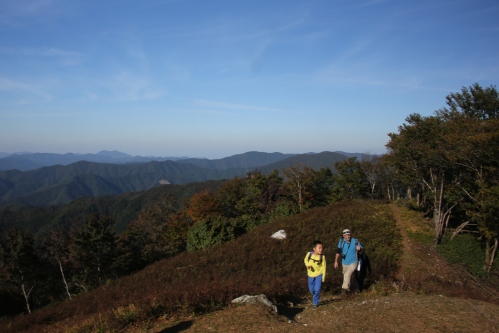
With peak #87 safely checked off the list, I could now focus solely on the remaining 13 mountains, all of which lay to the south of Osaka and few of which are accessible as a day trip. To add salt to the wounds, none of the peaks are accessible by public transport. It’s going to be a bit of a struggle to reach the magic #90 before the end of the year, but I am hatching up a plan to accomplish this with a little help from my friends.













